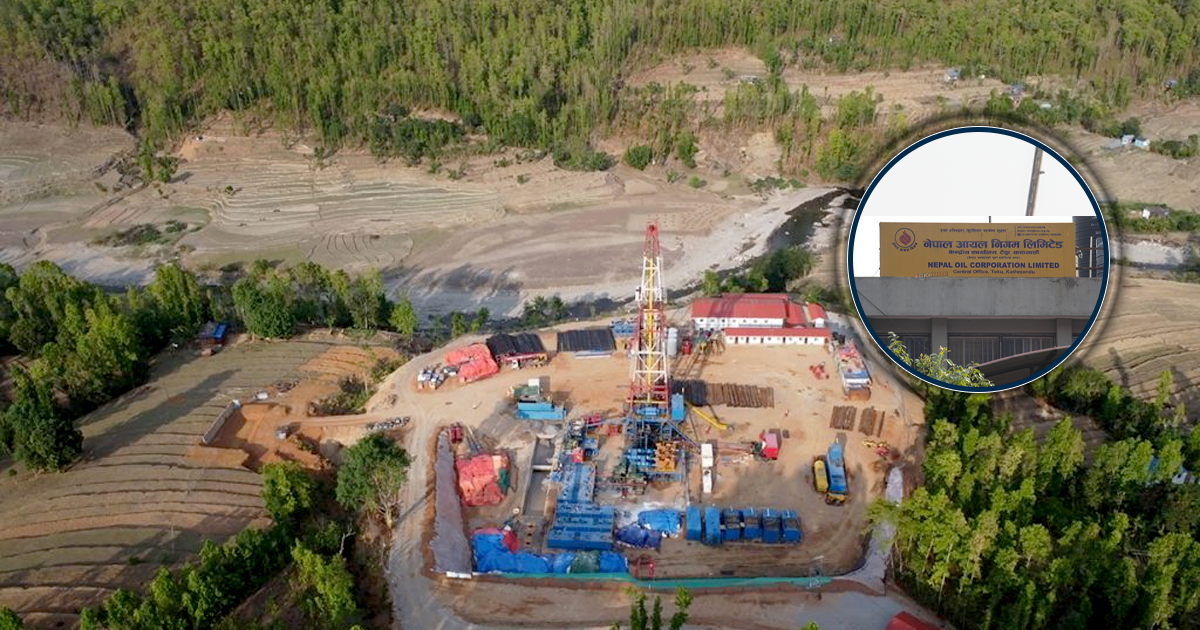Kathmandu: The government has formed a four-member technical study committee under the coordination of Nepal Oil Corporation (NOC) to begin commercial production of the large reserves of natural gas discovered in Dailekh.
The Ministry of Industry, Commerce and Supplies has constituted the committee under the leadership of NOC Director Binit Mani Upadhyaya to conduct a feasibility study and preparatory work for commercial natural gas production.
According to the ministry, the members of the committee include CDG Dharma Raj Khadka from the Department of Mines and Geology, CDE Manish Karna from the Petroleum Exploration Project, and NOC Assistant Manager Deepti Poudel as member-secretary.
The committee has been assigned the responsibility of completing the study and submitting its report within 30 days, based on a ministerial-level decision. The decision to form the committee was made on August 15 by Industry, Commerce and Supplies Minister Damodar Bhandari.
The committee is authorized to invite experts for discussions as needed. The costs for preparing the report will be managed by NOC, while the Petroleum Exploration Project will provide the necessary data and reports.
Earlier, on August 12, the Independent Employees’ Union of NOC, led by its president Bikash Bakhti, had submitted a seven-point memorandum to Executive Director Chandika Bhatta demanding that the corporation take ownership of the extraction, commercial production, and marketing of petroleum resources.
The union specifically urged NOC to take ownership of the methane gas discovered during petroleum exploration in Jaljale, Bhairavi Rural Municipality of Dailekh, for commercial production and trade. The union also demanded that this be done under NOC’s sole ownership, through a strategic partnership company, or by establishing a subsidiary company under NOC.
Based on this memorandum, Executive Director Bhatta had approached the ministry, and the current committee was formed as a result.
A previous study supported by the Chinese government had already confirmed the presence of petroleum resources, including methane gas, in Dailekh’s Jaljale area. On June 18, a Chinese expert team that had been conducting studies for a long time submitted a preliminary report to the government, confirming a large deposit of natural gas there.
The report concluded that during petroleum exploration in Dailekh, one of the four wells (NDP–1) contained 112.1 billion cubic meters (about 79.21 million metric tons) of natural methane gas.
The Department of Mines and Geology also confirmed that more than 90 percent of the content in the first well was natural gas.
According to the preliminary findings from the remaining three wells, an additional 317.9 billion cubic metres of natural gas is estimated to be present. However, the final detailed report will only be available by December.
Taken together, the four wells are estimated to hold around 430 billion cubic metres (about 303.34 million metric tons) of methane gas. Projections suggest that this amount could meet Nepal’s domestic gas demand for approximately 50 years.
The discovery was confirmed after rocks extracted during drilling emitted a gas odour, samples of which were sent to China for testing. The Chinese study team later verified the presence of a significant gas reserve.
According to the Department of Mines and Geology, this is the deepest and most scientifically advanced exploration project ever conducted in Nepal, with methane making up over 90 percent of the gas content.
The Chinese team has so far conducted geological route surveys across 1,000 kilometres in Dailekh, along with petroleum geological surveys covering 2,500 sq km, geochemical surveys over 800 sq km, remote sensing surveys spanning 5,000 sq km, and magnetotelluric surveys along 800 line-km.
Additionally, a 200 line-km 2D seismic survey and exploratory drilling up to 4,013 meters deep have been completed. Other essential tests, such as geophysical logging, mud logging, pyrolysis, gas chromatography, petrographic analysis, and PT analysis, have also been carried out.
This exploration began after a government-to-government (G2G) agreement between Nepal and China in 2019. Signs of natural gas and petroleum seepage had been observed in Dailekh since 1979, but serious exploration only took place later.
The 2015 unofficial blockade by India, which caused severe shortages of cooking gas and petroleum products, pushed the government to accelerate research into domestic alternatives.
A landmark agreement for petroleum exploration between Nepal and China was signed in 2019, which carried not only technical importance but also strategic significance. Initial exploration by Nepali and Chinese technicians confirmed the presence of petroleum and natural gas in Shirasthan and Nabhisthan areas of Dailekh, with estimates suggesting 6–7 potential sites.
The discovery was confirmed after rocks extracted during drilling emitted a gas odour, samples of which were sent to China for testing. The Chinese study team later verified the presence of a significant gas reserve.
The current study is being conducted as a pilot project, fully funded by the Chinese government, through the China Geological Survey. The estimated preliminary cost is 2.5 billion rupees, though delays due to the COVID-19 pandemic and other factors have raised expenses.
Prime Minister KP Sharma Oli had secured China’s agreement for a feasibility study during his visit in March 2016. This led to a cooperation agreement on petroleum exploration in 2016 and an implementation agreement in 2019. The agreement was signed by China’s Agency for International Economic Cooperation (under the Ministry of Commerce), China Geological Survey, and Nepal’s Department of Mines and Geology.
With a three-year extension, the project is set to run until March 2025. Exploration has also indicated potential petroleum reserves in Dang, Palpa, and Sunsari districts.
Currently, Nepal imports all its liquefied petroleum (LP) gas, used for cooking and some industrial purposes, from India via NOC. Annual demand is about 540,000 metric tons, with around 40 percent consumed in Kathmandu Valley and 60 percent outside.
Nepal spends around 53 to 60 billion rupees annually on importing cooking gas. NOC alone bears an annual loss of around 10 billion rupees, subsidizing each cylinder at about 250 rupees.
The new technical study committee has been tasked with analyzing the preliminary findings on Dailekh’s natural gas, studying the technical aspects of production, assessing infrastructure requirements, and examining possible uses of natural gas (fertilizers, electricity generation, cooking fuel), along with comparative cost analysis.
It will also analyze potential modalities for project operation, assess the availability of technical manpower, explore investment options, secure technical and financial assistance, and study the legal and financial feasibility of establishing a subsidiary company under NOC as a special purpose vehicle (SPV).



Comment Here